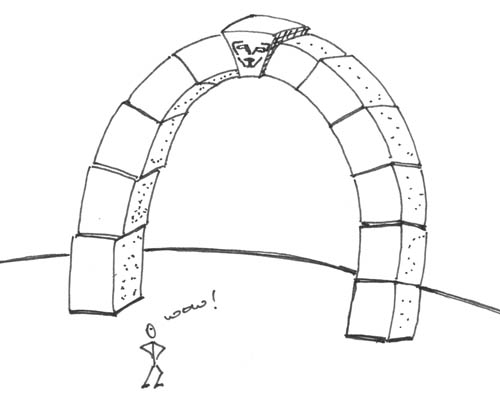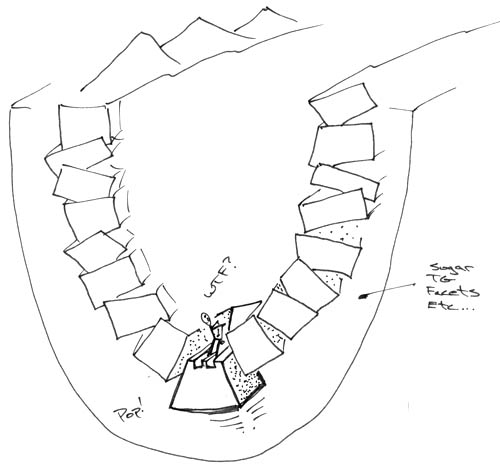Arches and Avalanches
One of the cruelest avalanche tricks out there is the old “I was just minding my own business skinning up a nice valley when suddenly both sides collapsed thousands of feet above me and I was buried 20′ deep.” It is a mean spirited trick as the skier may be on flat ground far away from the starting zone, and to add insult to injury, it is often fatal. This particular type of avalanche is different from the “wrong place, wrong time” slide where a skier happens to be below a slope when it decides to cut loose, because in this case, the skier is actually triggering the slide remotely from hundreds/thousands of feet away.
From studying Architecture, this phenomena reminds of an architectural arch, where all of the compression forces are balanced and held in place by a keystone at the top. Exhibit A below:
A collapsing valley is basically the same thing, except the arch it turned upside down, and instead of carved stones, you have a cohesive slab of snow. When an unsuspecting skier walks along the base of the valley, he is essentially knocking out the keystone that holds the valley walls up, as illustrated below:
This type of avalanche is very difficult to accurately predict, but not that hard to avoid. If the snowpack has pronounced collapsing (like the Wasatch has had this season), it means that keystone is being punched out and it would be better to stick to the high ground. The chances of getting caught in a slide like this are about a million to one (unless you live in Colorado, where it is more like 50/50) and the best defense is to be forewarned.
________________________________
Help support StraightChuter.com and pinpoint a deep burial quickly with a Pieps iPROBE Probe from Backcountry.com. Click on the photo below…
Category: 07 Avalanche Avoidance












As a Pennsylvanian telemark skier, I take offense to your analogy. First off, I doubt that Dynafit is the paramount binding selection. And secondly, I don’t think the symbol of a great state as Pennsylvania should be used in such a negative sense. Talk about ice or bare coverage if you want to imply death by skiing here. Keep up the good work – I read your blog everyday and count the days until I emigrate in Utah ….
nice drawings. you should do some more and show them in a gallery, er maybe a coffee shop.
Andrew,
Thanks for the sketch…. I made use of your idea while trying to explain how a slope needs and is benefited by having support… (and what might happen if it is removed..) Teaching level I avy courses in Shasta and Tahoe… Now I need to work on my drawing skills a bit.
Thx again, Rich
Hi Rich – glad to hear it was useful. I’d be happy to send you PowerPoint versions of those sketches if you need them for future presentations.
Low blow for Colorado. Utah is winning the avalanche fatalities this year though. 3 to 1.
Hopefully nobody was too offended as it was done in jest mainly to see if anyone from CO would even see it. ;)
This is an interesting post, but your model of avalanche formation is not correct.
Remote triggering usually involves thick layers of the persistent forms, or widespread weaknesses in storm snow such as heavier layers over lighter layers. When the weak layer collapses, the downward motion of the snow above the weak layer provides energy to drive fracture propagation. Imagine if you stepped on the top of the arch and the lowest blocks were suddently crushed by the extra weight? What would happen to the upper blocks?
The weak layer collapse, along with the subsequent propagation of the disturbance, causes a type of material failure referred to as delamination. The collapse breaks the intercrystalline bonds between the slab and the weak layer, leaving the upper slab “bonded” to the slope by static friction alone. If the slope is steep enough, gravity is able to overcome static friction and pull the slab, which results in the slab being torn away from its margins. The slab breaks apart as it moves downhill.
Read this paper:
http://www.issw2008.com/papers/P__8212.pdf
You’re probably familiar with firn quakes. The model of avalanche formation you attempt to describe is basically the same as a firn quake.
Firn Quakes
http://traverse.npolar.no/expedition-diary/archive/2007/12/21/firn-quake
The “WTF!” uttered by the little dude had me laughing out loud!!
The previous comment on avalanche science….not so much.
Hi Cookie Monster – I have no doubt that I may not have gotten the exact scientific terms correct, but in general, this is how I think of collapsing valleys and why I choose to avoid them in certain conditions, which ultimately helps keep me a bit safer. If there is collapsing and I’m looking at a narrow valley, I’ll avoid it.
I was just being a picky dillweed.